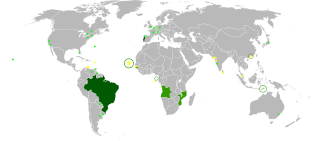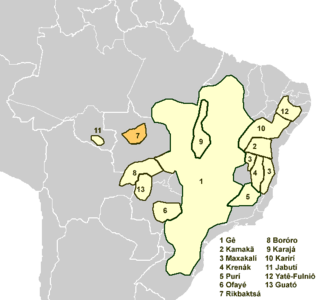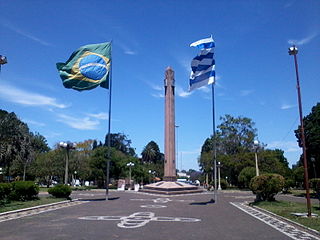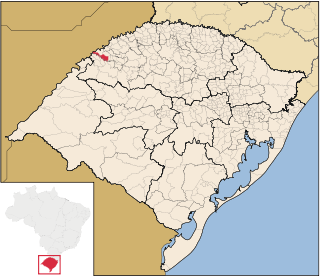 W
WPortuguese is the official and national language of Brazil and is widely spoken by most of the population. The Brazilian Sign Language also has official status at the federal level.
 W
WAmazonian languages is the term used to refer to the indigenous languages of "Greater Amazonia." This area is significantly larger than the Amazon and extends from the Atlantic coast all the way to the Andes, while its southern border is usually said to be the Paraná. The region is inhabited by societies that share many cultural traits but whose languages are characterized by great diversity. There are about 330 extant languages in Greater Amazonia, almost half of which have fewer than 500 speakers. Meanwhile, only Wayuu has greater than 100,000 speakers. Of the 330 total languages, about fifty are isolates, while the remaining ones belong to about 25 different families. Most of the posited families have few members. It is this distribution of many small and historically unrelated speech communities that makes Amazonia one of the most linguistically diverse regions in the world. The precise reasons for this unusual diversity have not yet been conclusively determined, but Amazonian languages seem to have had fewer than 10,000 native speakers even before the invasion of European colonists wrought havoc on the societies by which they were spoken. Despite the large-scale diversity, the long-term contact among many of the languages of Greater Amazonia has created similarities between many neighboring languages that are not genetically related. Most indigenous Amazonian people today are bilingual or even monolingual in Spanish or Portuguese, and many Amazonian languages are endangered as a result.
 W
WAntônio Carlos, Santa Catarina is a municipality in the state of Santa Catarina in the South region of Brazil.
 W
WArawan is a family of languages spoken in western Brazil and Peru (Ucayali).
 W
WArutani–Sape, also known as Awake–Kaliana or Kalianan, is a proposed language family that includes two of the most poorly documented languages in South America, both of which are now extinct. They are at best only distantly related. Kaufman (1990) found a connection convincing, but Migliazza & Campbell (1988) maintained that there is no evidence for linking them. The two languages are,Arutani Sape
 W
WAugusto Pestana is a Brazilian municipality in the State of Rio Grande do Sul. It is located at 28°31′01″S 53°39′01″W, at an altitude of 390 m. The city is 320 km northwest of Porto Alegre, 1,540 km southwest of Brasília and just 120 km east of the border with Argentina.
 W
WThe Borôroan languages of Brazil are Borôro and the extinct Umotína and Otuke. They are sometimes considered to form part of the proposed Macro-Jê language family, though this has been disputed.
 W
WCarib or Kari'nja is a Cariban language spoken by the Kalina people (Caribs) of South America. It is spoken by around 7,400 people mostly in Venezuela, Guyana, Suriname, French Guiana, and Brazil. The language is currently classified as highly endangered.
 W
WThe Chapacuran languages are a nearly extinct Native American language family of South America. There are three living Chapacuran languages which are spoken in Rondônia in the southern Amazon Basin of Brazil and in northern Bolivia.
 W
WEast Low German is a group of Low German dialects spoken in north-eastern Germany as well as by minorities in northern Poland. Together with West Low German dialects, it forms a dialect continuum of the Low German language. Before 1945, the dialect was spoken along the entire then-German-settled Baltic Coast from Mecklenburg, through Pomerania, West Prussia into certain villages of the East Prussian Klaipėda Region.
 W
WGuaraní, specifically the primary variety known as Paraguayan Guarani, is a South American language that belongs to the Tupi–Guarani family of the Tupian languages. It is one of the official languages of Paraguay, where it is spoken by the majority of the population, and where half of the rural population is monolingual. It is spoken by communities in neighboring countries, including parts of northeastern Argentina, southeastern Bolivia and southwestern Brazil, and is a second official language of the Argentine province of Corrientes since 2004; it is also an official language of Mercosur.
 W
WGuató is a possible language isolate spoken by 1% of the Guató people of Brazil.
 W
WThe Jê languages, or Jê–Kaingang languages, are spoken by the Jê, a group of indigenous peoples in Brazil.
 W
WKaiwá is a Guarani language spoken by about 18,000 Kaiwá people in Brazil in the state of Mato Grosso do Sul and 510 people in northeastern Argentina. Literacy is 5-10% in Kaiwá and 15–25% in Portuguese. Kaiwá proper is 70% lexically similar with the Pai Tavytera language, and its similarity to its linguistic cousin Guaraní, one of the two national-languages of Paraguay alongside the Spanish language, means it is even sometimes considered mutually intelligible.
 W
WKarajá, also known as Iny rybè, is spoken by the Karajá people in some thirty villages in central Brazil.
 W
WKukurá is a spurious language, fabricated by an interpreter in Brazil.
 W
WMato Queimado is a Brazilian municipality located in the northwestern part of the state of the Rio Grande do Sul. The population is about 1,629 in an area of 114.64 km². It is located 489 km in the west of the state capital of Porto Alegre and northeast of Alegrete.
 W
WYanam, or Ninam, is a Yanomaman language spoken in Roraima, Brazil and southern Venezuela near the Mucajai, upper Uraricaá, and Paragua rivers.
 W
WThe Ofayé or Opaye language, also Ofaié-Xavante, Opaié-Shavante, forms its own branch of the Macro-Jê languages. It is spoken by only a couple of the small Ofayé people, though language revitalization efforts are underway. Grammatical descriptions have been made by the Pankararú linguist Maria das Dores de Oliveira (Pankararu), as well as by Sarah C. Gudschinsky and Jennifer E. da Silva, from the Universidade Federal do Mato Grosso do Sul.
 W
WOtuke is an extinct language of the Macro-Jê family, related to Bororo. Otuke territory included what is now the Otuquis National Park and Integrated Management Natural Area in eastern Bolivia.
 W
WPanoan is a family of languages spoken in Peru, western Brazil, and Bolivia. It is possibly a branch of a larger Pano–Tacanan family.
 W
WBrazilian Portuguese or also português sul americano is the set of dialects of the Portuguese language native to Brazil and the most influential form of Portuguese worldwide. It is spoken by almost all of the 200 million inhabitants of Brazil and spoken widely across the Brazilian diaspora, today consisting of about two million Brazilians who have emigrated to other countries. With a population of over 210 million, Brazil is by far the world's largest Portuguese-speaking nation and the only one in the Americas.
 W
WPortuguese is a Romance language originating in the Iberian Peninsula of Europe. It is the sole official language of Portugal, Angola, Mozambique, Guinea-Bissau, Cape Verde, São Tomé and Príncipe, and Brazil, while having co-official language status in East Timor, Equatorial Guinea, and Macau. A Portuguese-speaking person or nation is referred to as "Lusophone". As the result of expansion during colonial times, a cultural presence of Portuguese and Portuguese creole speakers are also found around the world. Portuguese is part of the Ibero-Romance group that evolved from several dialects of Vulgar Latin in the medieval Kingdom of Galicia and the County of Portugal, and has kept some Celtic phonology in its lexicon.
 W
WPortuñol or Portunhol is a portmanteau of the words portugués/português ("Portuguese") and español/espanhol ("Spanish"), and is the name often given to any unsystematic mixture of Portuguese and Spanish.. Close examination reveals it to be "a polyvalent term (portuñol/portunhol) used to describe a wide range of phenomena, including spontaneous contact vernaculars in border regions, errors produced by speakers attempting to speak the L2 correctly, and idiosyncratic invented speech designed to facilitate communication between the two languages."
 W
WThe Rikbaktsa language, also spelled Aripaktsa, Erikbatsa, Erikpatsa and known ambiguously as Canoeiro, is a language spoken by the Rikbaktsa people of Mato Grosso, Brazil, that forms its own branch of the Macro-Gê languages.
 W
WUruguayan Portuguese, also known as fronteiriço and Riverense, and referred to by its speakers as portunhol, is a variety of Portuguese with heavy influence from Rioplatense Spanish. It is spoken in north-eastern Uruguay, near the Brazilian border, mainly in the region of the twin cities of Rivera (Uruguay) and Santana do Livramento (Brazil). This section of the frontier is called Frontera de la Paz, because there is no legal obstacle to crossing the border between the two countries.
 W
WRoque Gonzales is a municipality located in the northwestern region of the southernmost state of Rio Grande do Sul, Brazil, not very far from Argentina which is located to the west, across the Uruguay River. Roque Gonzales was named after the jesuit missionary and saint Roque González de Santa Cruz.
 W
WSanumá or Sanöma is a Yanomaman language spoken in Venezuela and Brazil. It is also known as Sanema, Sanima, Tsanuma, Guaika, Samatari, Samatali, Xamatari and Chirichano. Most of its speakers in Venezuela also speak Ye'kuana, also known as Maquiritare, the language of the Ye'kuana people the Sanumá live alongside in the Caura River basin.
 W
WShipibo is a Panoan language spoken in Peru and Brazil by approximately 26,000 speakers. Shipibo is an official language of Peru.
 W
WTacanan is a family of languages spoken in Bolivia, with Ese’ejja also spoken in Peru. It may be related to the Panoan languages. Many of the languages are endangered.
 W
WTicuna, or Tikuna, is a language spoken by approximately 50,000 people in the Amazon Basin, including the countries of Brazil, Peru, and Colombia. It is the native language of the Ticuna people. Ticuna is generally classified as a language isolate, but may be related to the extinct Yuri language and there has been some research indicating similarities between Ticuna and Carabayo. It is a tonal language, and therefore the meaning of words with the same phonemes can vary greatly simply by changing the tone used to pronounce them.
 W
WThe Tupi or Tupian language family comprises some 70 languages spoken in South America, of which the best known are Tupi proper and Guarani.
 W
WThe Yabutian or Jabutian languages are two similar moribund languages of southern Rondônia, Brazil, namely Arikapú (Maxubí) and Djeoromitxi (Yabutí/Jabotí). They are members of the Macro-Je language family.
 W
WYanomamö (Yąnomamɨ) is the most populous of several closely related languages spoken by the Yanomami people. Most speakers are monolingual. It has no natively-used writing system. For a grammatical description, see Yanomaman languages.